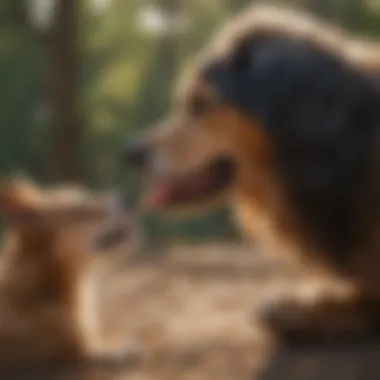Understanding Why Dogs Lick: Behavioral Insights


Intro
Dogs, with their affectionate licks, often adorn our lives with warmth and companionship. However, have you ever paused to wonder why your furry friend engages in this often-repetitive behavior? It’s not just a mere show of affection or a random quirk; there's a whole tapestry of reasons woven into this licking habit. By exploring the layers behind this behavior—ranging from psychological to social influences—we can better understand our canine companions.
Licking can sometimes appear to be an innocuous act, a simple gesture of love or a request for attention. Yet, there’s much more beneath the surface. This article aims to peel back those layers and delve into not only the motivations behind a dog’s lick but also the implications for their health and well-being.
Through our exploration, pet owners can gather valuable insights into what their dogs are trying to communicate, how to foster a happy connection, and when to consult a vet. The journey will also cover some practical tips for managing licking behavior, ensuring that the bond with our pets remains strong and healthy.
As we embark on this detailed examination, let's consider how understanding the reasons behind licking can enhance the relationship between you and your canine partner. Should we dive deeper into the essentials of caring for those loving licks? Let's start with the core elements of pet care.
The Intricacies of Canine Behavior
Understanding canine behavior is not just a mere academic exercise; it’s essential for anyone who shares their life with a dog. The way dogs behave, including their tendency to lick, is a window into their world. While some may shrug it off as just a quirky habit, there’s a depth to this seemingly simple action that speaks volumes about their needs, emotions, and instincts.
Defining Dog Behavior
Defining dog behavior involves more than just observing actions; it’s about interpreting the meanings behind those actions. Dogs communicate not just through barks or growls, but also through body movements and licking. For instance, a dog might lick excessively when it’s anxious. This act can signify a number of things, like seeking comfort or trying to tell you they need something.
In a household, your dog’s licking can vary significantly based on context. If they’re licking you after a long day, it can be their way of showing love or seeking attention. This behavior is key when it comes to building a relationship. Understanding these nuances aids owners immensely in responding appropriately to their dogs’ needs.
The Importance of Natural Instincts
Natural instincts play a staggering role in how dogs interact with their surroundings. Dogs are descendants of wolves, creatures that rely heavily on instinct for survival. Licking, as a behavior, is ingrained in their genetics. Puppies lick their mothers as a means of communication and nourishment; this instinct persists throughout their lives.
This instinctive behavior has practical implications. For example, a dog licking its owner can stem from an innate desire to establish relationships, similar to how a wolf would groom its pack members. When a dog chooses to lick, it often reflects their need for social bonding or reassurance. Thus, recognizing and respecting these natural instincts is paramount for pet owners. If a dog is licking due to instinctual reasons, punishing such behavior could lead to confusion and resentment rather than a solution.
Understanding why dogs lick is not merely an intellectual pursuit; it’s a pivotal piece for fostering a deeper connection between the pet and its owner. By recognizing the behaviors that shape our dogs, we can anticipate their needs and respond in ways that strengthen that bond.
"A dog's love is not just in its wagging tail but also in its gentle nuzzle, a reminder of the connection we share."
In summary, the intricacies of canine behavior are crucial for varying interactions – whether playful or anxious – and they require thoughtful interpretation. Through the lens of behavior, we can better foster mutual understanding and trust.
Understanding Licking as Communication
When it comes to understanding canine behavior, the act of licking plays a crucial role in how dogs interact with their environment and the beings in it. This section explores the prominence of licking as a form of communication between dogs and humans, shedding light on its various dimensions and implications for pet owners.
Licking as Social Interaction
Licking, in many ways, can be viewed as a dog’s way of saying, "Hello!" or even "I'm here!" It's a behavior deeply embedded in canine interactions. Dogs may lick each other as a way of greeting, showing affection, or even seeking attention. Notably, mother dogs lick their puppies to groom them and stimulate their anatomy. This instinct tends not to fade as they age. Rather, it gets transferred to relationships with humans.
For example, a dog returning from a short trip outside might run to its owner and start licking their hands or face. This act could mean it is expressing joy at seeing them again or asking for attention. Similarly, if a dog observes its owner feeling down, it may lick in an attempt to comfort or bond, acknowledging the owner’s emotions.
Here are some key points to consider about licking as social interaction:
- Affectionate Gesture: Dogs often lick as a sign of affection, indicating a bond of trust.
- Attention-seeking Behavior: Some dogs might lick to solicit attention or playtime.
- Communication: Licking can serve as a means for dogs to communicate feelings or needs to us and other canines.
The Role of Body Language
Understanding a dog's body language can greatly enhance our comprehension of its licking behavior. Dogs are non-verbal creatures, and they rely heavily on their physical gestures, combined with licking, to express themselves. For instance, a dog that approaches with a wagging tail while licking is likely expressing excitement and friendliness. Conversely, if a dog appears tense with hesitant licking, it could indicate anxiety or discomfort.
Attention must be given to context as well. For instance, a dog might lick it’s owner after being scolded, which can signal a desire to reconcile or an attempt to submit. The interplay between licking and body language becomes an essential part of canine communication. Here are aspects to observe:
- Tail Position: High and wagging suggests happiness, while tucked tails could point towards submission.
- Ears: Positioning of ears can indicate how receptive a dog is; relaxed ears often accompany playful licking.
- Eyes: Soft, gentle eye contact generally means a praise for the dog, while darting or looking away can suggest fear or apprehension.


Understanding the fine nuances of licking as a form of communication not only enhances our relationship with our dogs but also helps in recognizing their emotional states. As we become more attuned to their signals, we can respond more aptly to their needs, fostering a deeper bond that can alleviate many behavioral issues.
Licking is more than just a habit; it's a conversation without words, a bridge between canine and human understanding.
The Psychological Motivations Behind Licking
Understanding the psychological aspects behind a dog's licking behavior is as vital as recognizing the physical manifestations of their actions. This section will delve into the underlying mental triggers that fuel licking, shedding light on why this common behavior often goes beyond mere interaction. By grasping these motivations, pet owners can foster a deeper relationship with their furry companions, addressing their needs more effectively and promoting a more harmonious coexistence.
The Comforting Effect
One of the primary psychological motivations for why dogs lick is tied to comfort. When dogs lick, it can often be perceived as self-soothing behavior. Just as humans may find solace in rhythmic actions like tapping fingers or biting nails, dogs derive a sense of calm from licking.
- Familiarity and Security: When puppies are separated from their mothers, they might lick themselves or their littermates as a way to reconnect with that sense of safety. This instinct can persist into adulthood, explaining why an older dog may seek comfort through licking its owner's hand or face during stressful situations.
- Reduction in Anxiety: Research has shown that repetitive behaviors can trigger a release of endorphins in the brain, promoting relaxation. A dog might lick its owner or even its own paws as a way to cope with anxiety or uncertainty, especially during changes in their environment or routine.
Dogs are keenly aware of their owner's emotional states. A simple lick can be their way of extending comfort when you're feeling blue. It’s their method of communicating that they’re there for you, offering consolation in moments of distress. Owners often find their dogs responding to their moods, and licking can become an affectionate response to an owner’s sorrow.
"Dogs are not just pets; they are family members who sense our feelings, and licking can often serve as their way to offer us love and comfort."
Stress Relief Mechanism
Dogs, much like humans, experience a range of emotional ups and downs, and sometimes they need ways to cope with their stress. Licking serves as an outlet for those feelings, acting as a mechanism for self-regulation.
- Frustration and Boredom: Dogs that feel stuck or overwhelmed might resort to licking as an escape route. Engaging in licking can provide temporary relief from confusion or boredom. If left without mental stimulation, they might turn to licking surfaces, toys, or even themselves to release pent-up energy.
- Compulsive Behavior: In some cases, excessive licking can spiral into compulsive behaviors. This doesn't just occur with emotional stress but may also be the result of environmental stresses, like loud noises, unfamiliar pets, or changes in the household. Addressing the root causes—whether it's enhancing their environment or ensuring a structured routine—can help mitigate this behavior.
The importance of recognizing these triggers cannot be overstated. Intervening early when signs of stress or anxiety appear can prevent further behavioral issues down the line. By integrating mental exercises and establishing a safe, consistent routine, pet owners can promote a calmer approach to life for their dogs.
All in all, the psychological motivations behind licking go hand in hand with the emotional landscape of a dog. Whether for comfort or as a response to stress, being aware of these motivations enriches the bond between a dog and its owner.
Physiological Factors Influencing Licking
Understanding the physiological factors that influence a dog's licking behavior is crucial for pet owners. This behavior can reveal a lot about a dog's health, preferences, and even emotional state. By breaking down the elements that play a role in why dogs lick—two primary areas of interest emerge: taste and texture attraction, and health-related behaviors. Both of these aspects provide insights into how dogs interact with their environment and those around them.
Taste and Texture Attraction
Dogs, much like humans, have their preferences, especially when it comes to what they enjoy licking. The flavor profiles and the texture of what they encounter are significant contributors to their licking habits. Many dogs are naturally drawn to salty or sweet tastes. For instance, after a long walk, when their owner has been sweating, dogs might lick their owner's skin because of the salty sweat.
Not only does this behavior stem from taste, but texture also plays a key role. A dog's mouth is sensitive and they often explore their world through licking, which can certainly be linked to tactile sensations. A rough surface may provoke one type of licking, while smooth, soft objects may induce a completely different response. If you've ever watched as a dog licks a piece of crunchy food or a rawhide, it’s clear they might be relishing the texture as much as the taste.
Interestingly, dogs may also lick to soothe themselves, finding comfort in the act of licking certain textures, be it a couch, a blanket, or even their own paws. Thus, by understanding this attraction to taste and texture, owners can better manage their dogs' environments and potentially redirect their licking behaviors towards more appropriate targets.
Health-Related Behaviors
From a health perspective, licking can serve various important functions in a dog's lifecycle. For example, if a dog excessively licks a certain area of its body, it could be trying to signal an underlying health issue. This prompts a deeper investigation into their physical wellness. Commonly, issues such as allergies, infections, or skin irritations lead to increased licking as the dog attempts to relieve discomfort.
"Excessive licking is often a red flag indicating that the dog might need medical attention."
Being observant here is essential. Pet owners should keep an eye on patterns in licking behavior, as recognizing these signs early can make a difference in health outcomes. Additionally, dogs sometimes lick their owners or other animals to groom them, which is a natural instinct stemming from their ancestry. This is not only a behavior linked to care and social bonding but also promotes hygiene.
On the flip side, an animal that licks frequently might be experiencing stress or anxiety. In such cases, consulting with a veterinarian or an animal behaviorist can help identify if there's a physical condition causing this behavior, or if it's purely psychological. It’s vital that pet owners become educated on these various health-related behaviors, as they hold the key to ensuring their furry companions lead healthy, happy lives.
The Impact of Early Socialization
Early socialization plays a crucial role in shaping a dog's behavior, especially when it comes to habits like licking. Understanding this early phase can help owners significantly foster desired behavior traits in their pets. A dog's formative experiences can influence how they express affection, discomfort, or anxiety later in life. If a puppy is well-socialized, they will develop healthier coping mechanisms and better communication strategies with both humans and other animals.
Influence of Puppy Experiences


The experiences that a puppy has during its early months are like the groundwork of a building; they support everything that comes after. A well-socialized puppy is exposed to various environments, people, and other dogs. This exposure helps the puppy learn what is normal and acceptable behavior. For instance, a puppy that interacts positively with various stimuli is likely to lick as a form of friendly communication rather than out of anxiety or insecurity.
For example, if a puppy is gently encouraged to explore different settings—like parks filled with other dogs or safe interactions with kids—they learn to adapt and respond to new situations with confidence. They might lick as a greeting or to bond with their human and furry friends within these contexts. In this regard, licking can become a healthy part of their social interactions, reflecting comfort and trust rather than discomfort.
Reinforcement of Licking Behavior
Reinforcement plays a big part in determining whether a dog continues to lick as a form of communication or affection. If, during critical developmental periods, a puppy receives positive feedback after licking—be it affection from the owner, treats, or even playful interactions—they are more likely to repeat the behavior later on. It’s a simple case of cause and effect.
"Dogs, like many creatures, learn from their experiences; they find comfort in what is positively reinforced."
On the flip side, if a puppy is scolded or pushed away when licking, it may not only stop this behavior but could also develop a fear of expressing its affections altogether. Thus, a careful balance is necessary. Owners should aim to create a supportive environment where licking is viewed as normal and accepted.
A few things can help in reinforcing licking as a positive behavior:
- Praise: Use verbal affirmations when your puppy engages in licking during playtime or when greeting you.
- Interaction: Engage your puppy during these moments to make them feel valued.
- Consistency: Create a routine that allows your puppy to confidently express their feelings through licking without negative repercussions.
By focusing on proper early socialization and reinforcing positive licking behavior, pet owners can foster healthy communications and emotional connections with their dogs.
Potential Health Issues Related to Excessive Licking
Excessive licking in dogs can signal more than just a behavioral quirk; it often raises red flags regarding their health. It’s essential for pet owners to recognize the implications this behavior presents. Understanding potential health issues related to excessive licking enables owners to take proactive steps, ensuring their furry friends maintain their well-being.
When a dog licks more than usual, it can be indicative of underlying medical conditions or emotional distress. Identifying these issues early is crucial, as they may spiral into more significant concerns if left unaddressed. Here, we’ll explore two key aspects that stand out: skin conditions and indicators of anxiety.
Skin Conditions and Allergy Indicators
Dogs may lick obsessively due to skin irritations or allergies, often reflectivity licking at sore spots or inflamed areas. Some common skin conditions leading to this include:
- Allergic Reactions: Dogs can have allergies to various substances, from food to environmental triggers like pollen. When exposed, they may lick to soothe the discomfort.
- Fleas or Ticks: Infestations can lead to itching, prompting a dog through constant licking to alleviate such persistent irritations.
- Dermatitis: Different types of dermatitis can cause rashes or flaky skin, leading dogs to lick as a form of self-soothing.
Beyond alleviating immediate discomfort, licking these areas often leads to secondary infections. When the skin is broken, bacteria get a chance to enter, causing infections that might require vet interventions.
Behavioral Signs of Anxiety
Anxiety is another major contributor to excessive licking. Dogs can be creatures of habit, and anything disrupting their routine or environment might provoke significant stress. Here are some signs that might accompany anxiety-driven licking:
- Destructive Behaviors: If a dog starts chewing furniture or digging excessively, that's often a telltale sign that they are distressed.
- Barking or Whining: Increased vocalization can indicate anxiety, and when paired with licking, it underscores emotional turmoil.
- Hiding or Retreating: If your pet seeks solitude, frequently licking in an attempt to self-soothe, it’s a signal they need reassurance.
Excessive licking can often spin a web of issues—what starts as a simple action can turn into a complex interplay of physical and emotional health.
Being vigilant regarding a dog's licking habits provides insights into their overall health and happiness. Understanding the root causes can help pet owners create effective management strategies, nurtur their pets correctly, and when needed, consult with veterinarians for tailored solutions.
Appropriate Responses to Licking
Understanding how to respond to a dog's licking behavior is crucial for fostering a healthy relationship between the pet and its owner. When a dog licks, it can be a simple act of affection or a means of communication. However, the way owners react to this behavior can significantly influence whether it continues or changes. Knowing appropriate responses helps in creating a peaceful cohabitation and promotes a better understanding of each other's needs.
A balance of recognizing the dog's motives while implementing effective responses can nurture positive interactions. This section deep dives into how pet owners can navigate this behavior by using positive reinforcement strategies and establishing boundaries.
Positive Reinforcement Strategies
Positive reinforcement is a powerful tool for modifying dog behavior. By rewarding desirable actions rather than punishing unwanted behavior, owners can encourage their pets to express themselves in a more desirable way. Here’s how to implement positive reinforcement in response to licking:
- Identify Trigger Situations: Notice when your dog tends to lick. Is it during playtime, when they’re anxious, or when a new person is around? Understanding triggers allows for targeted responses.
- Redirect the Behavior: When your dog starts licking, redirect their attention to a toy or engage in an active game. This shifts their focus and teaches them that play is more rewarding than licking.
- Reward Alternative Behaviors: Whenever your dog chooses to engage in an alternative behavior, such as sitting or chewing on a toy instead of licking, be quick to offer praise or a treat. This reinforces the idea that good things happen when they behave differently.
- Be Consistent: Consistency is key. Everyone in the household should respond in the same manner to licking behaviors. A united front helps the dog learn faster and reduces confusion.


Setting Boundaries
Setting clear boundaries regarding licking is essential for both the owner and the dog. Dogs often require guidance on what is acceptable behavior, especially in a home setting. Here’s how to effectively set boundaries:
- Establish Rules: Decide where licking is acceptable. Is it okay for them to lick your hands but not your face? Clear rules help the dog understand what’s allowed.
- Timeouts for Excessive Licking: If a dog does not respond to other methods and continues licking excessively, consider giving them a short timeout. This isn’t a punishment, but rather a moment for the dog to calm down and regroup.
- Communicate Clearly: Use simple cues such as "No lick" in a firm but calm voice when your dog begins to lick inappropriately. Reinforce this command with consistency.
- Practice Patience: Training takes time. Dogs don’t learn overnight, so be patient, and give your pet the time needed to adjust their behavior.
It’s essential to remember that licking can serve various purposes, from seeking affection to expressing anxiety. Tailoring your responses to your dog’s unique needs will not only enhance their wellbeing but strengthen your bond.
By integrating positive reinforcement strategies and setting boundaries, pet owners can cultivate a more harmonious living environment. Knowing how to appropriately respond to licking behaviors helps maintain a loving and respectful dynamic between dogs and their humans.
Cultural Perspectives on Dog Licking
Exploring cultural perspectives on dog licking brings to life how societies interpret and respond to this behavior. Different cultures have unique attitudes towards not only dogs but also their actions, encapsulating a spectrum of values and beliefs that affect pet ownership. Considering these cultural nuances is vital in understanding the complex relationship humans share with their canine companions.
In some cultures, dogs are not merely pets, but they serve as working animals, guardians, or even spiritual symbols. This relationship shapes expectations regarding their behavior. For instance, in certain Asian cultures, dogs may be viewed as symbols of luck or prosperity, influencing how their behaviors are interpreted by their owners. Here, a lick might be seen as a sign of gratitude or acknowledgement, rather than just a common canine behavior. Conversely, in some Western societies, dog licking is primarily viewed within the context of companionship. The affectionate licks of a dog may symbolize trust and love, reinforcing the bond between pet and owner.
Understanding the significance of licking within various cultural contexts allows pet owners to appreciate their dogs beyond mere behaviors—it reflects socio-cultural frameworks that can enhance the pet-human relationship.
Cultural Attitudes Toward Licking
Cultural attitudes towards licking vary significantly. In some households, dog licking is embraced as part of an endearing, loving dynamic. These families might encourage licking as a way to express love and affection. An example can often be seen in homes where dogs are treated as full-fledged family members. Here, the pet’s licking can be understood as positive communication, reinforcing social bonds amongst all household members.
On the flip side, in more traditional or rural settings, licking may be regarded with less affection, associated with unruliness or lack of discipline. Owners might consider it a sign that the dog needs training or that it has improper self-control. Such attitudes can influence how people interact with their dogs, prompting interventions when licking behavior escalates.
This divergence in beliefs can sometimes result in conflicts between owners and their pets. Acknowledging the cultural backdrop can help pet owners tailor their responses to their dogs’ behaviors, fostering a more harmonious relationship.
Historical Context of Canine Behavior
The history of domestic dogs intertwines with human societies, shaping how various cultures perceive and react to canine behaviors, including licking. For thousands of years, dogs have been associated with hunting, herding, and companionship. Across different civilizations, the roles of dogs have evolved based on societal needs and cultural priorities.
Initially, licking was often tied to survival instincts — think of a mother dog cleaning her puppies. This behavior also has roots in wild canines, where licking serves to bond social groups and foster kinship. Over time, as dogs transitioned from wild to domesticated, their behaviors adapted to human lifestyles, yet some ancient traits persisted.
In societies where dogs are seen as working animals, licking may not receive the same affectionate interpretation. In contrast, cultures valuing companionship often attribute emotional meanings, associating licking with affection and loyalty. By tracing historical patterns, one gains insights into how socio-economic structures and human preferences have intricately informed our interpretations of such seemingly simple canine actions as licking.
"The tale of dogs is not merely about loyalty; it is a narrative enriched by culture and history that continues to unfold in everyday interactions."
This blend of cultural attitudes and historical contexts has significant implications for modern dog ownership. Recognizing these diverse perspectives can enhance empathy toward canine behaviors, leading to better communication and understanding between pets and their owners.
When discussing dog licking, it becomes clear that cultural insights add a layer of complexity that enriches the understanding of our furry friends. By incorporating knowledge from various cultures, pet owners cultivate a broader appreciation of their companions, while also fostering practices that honor each dog’s unique personality and communication style.
Ending: Embracing Understanding
In wrapping up our exploration of why dogs engage in licking behavior, it's crucial to recognize the complexities that lie beneath this simple action. Understanding why dogs lick not only enriches our relationship with them but also empowers us to make informed decisions about their care and wellbeing. Recognizing the blend of genetic, environmental, and psychological factors melded into this behavior can help pet owners navigate their dogs’ needs more effectively.
This discussion has highlighted several layers of understanding, from the basic instincts rooted deep in canine genetics to the subtle social cues in their environment. As pet owners, becoming aware of these nuances allows us to interpret our furry friends' actions with a more analytical lens.
"To know the reason behind a dog's lick is to understand a piece of their soul."
Summarizing Key Insights
Throughout this article, we have tackled various aspects of licking behavior:
- Communication: Licking is a critical part of how dogs convey feelings and messages to their humans; it's not merely a physical act but rich in meaning.
- Psychological Factors: Dogs derive comfort and a sense of security through licking, helping them cope with stress and anxiety.
- Health Considerations: Excessive licking can sometimes indicate underlying health issues, making it essential for owners to remain vigilant and proactive.
- Cultural Influences: Different cultures have unique perspectives on canine behavior, which shapes how both pets and owners relate to one another.
By synthesizing these insights, we see licking as a multifaceted behavior that can tell us much about a dog's state of mind and health.
Future Considerations for Pet Owners
As you move forward armed with knowledge about licking behavior, consider the following:
- Monitoring Behavior: Keep a close watch on your dog's licking habits. If licking becomes excessive or changes suddenly, consult your vet.
- Encouraging Positive Interactions: When your dog licks you, think about the context. If you want to encourage a different behavior, redirect their attention to toys or activities that are constructive.
- Socialization Opportunities: Provide your dog with varied social experiences to help them develop their communication skills beyond licking.
- Educating Yourself: Continually invest time in learning about canine behavior. Resources like Wikipedia, Britannica, and Reddit can be valuable for understanding evolving research in animal behavior.







